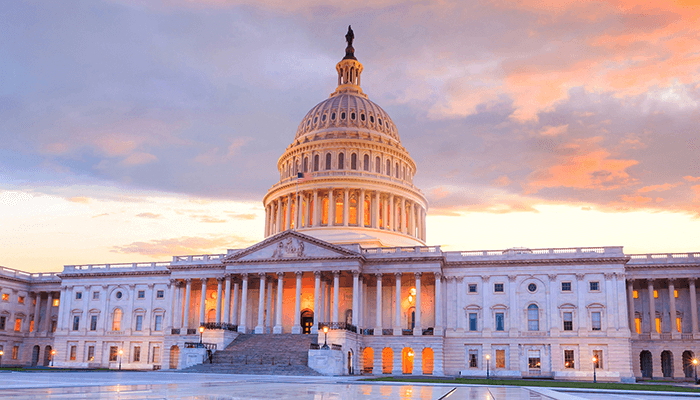CBO’s “Other Mandatory” Savings Options
Update: The offset options below were estimated prior to enactment of the One Big Beautiful Bill Act (OBBBA) and have not been updated. Some options are no longer applicable in the form they are presented, and others would result in substantially different savings. A breakdown of the savings enacted under OBBBA is available here.
The Congressional Budget Office (CBO) recently released its Options for Reducing the Deficit, outlining 76 policy options to reduce the deficit. Most of the largest options relate to the cost of Social Security and health care – the largest parts of the budget – or to revenue. CBO also included a variety of options related to “other mandatory” programs, such as benefits for veterans and federal workers, means-tested programs, and premiums and fees.
The below options could save up to $1 trillion through 2035.1 They are the latest addition to our Budget Offsets Bank, which includes many trillions of dollars’ worth of spending and revenue options to reduce the deficit and offset new initiatives.
Note: these options are based on the FY 2026-2035 budget window; savings would likely be 15 percent less over the FY 2025-2034 budget window, varying by option. Savings are estimates based on CBO scoring, are rounded to the nearest $5 billion, and are subject to change based on policy specification.
The table below is a menu of options and does not represent recommendations from the Committee for a Responsible Federal Budget, its board, or its staff.
Other Mandatory Savings Options to Reduce the Deficit
All numbers rounded to the nearest $5 billion. Most estimates are based on Congressional Budget Office (CBO) scores and figures.
*Funding for the Pell grant program has discretionary and mandatory components. Restricting eligibility for Pell Grants would lower mandatory spending by $10 billion and lower discretionary spending by $25 billion between 2025-2034.
One area of savings relates to the health and retirement benefits provided to federal employees, both civilian and members of the military. CBO estimates the government could save $20 billion over a decade by indexing the Federal Employee Health Benefits (FEHB) voucher to inflation and a similar amount by charging military retirees a $610 annual fee to enroll in TRICARE for Life (TFL) wrap-around health benefits. Alternatively, restricting the ability of these TFL plans to cover first-dollar expenses would save $35 billion, including by reducing the cost of the Medicare program. Finally, increasing civilian employee retirement contributions — so that nearly all federal employees pay 4.4 percent of their salary as opposed to only those hired in 2014 or later — would save about $40 billion (this is technically federal revenue but is generally understood to be an offsetting receipt as opposed to a tax).
CBO also puts forward a number of savings options related to veterans’ programs. Most significantly, the federal government would save $440 billion over a decade by means-testing veterans’ disability payments so that they phase out for those with income above $135,000 per year (the top 30 percent). The government could save up to $70 billion ($15 billion for new applicants) by restricting veterans disability benefits to those with a disability rating of 30 percent or more and could save a similar amount by eliminating Individual Unemployability payments for those above the normal retirement age.
Targeting income-related benefits of mandatory programs could generate additional savings. Tightening eligibility for the mandatory component of the Pell Grant program could save $10 billion over a decade or even more when targeting the discretionary component, or $50 billion could be saved from eliminating the mandatory add-on component of Pell grants altogether. Eliminating nutrition subsidies to households with incomes greater than 185 percent of the federal poverty level — which includes certain meals in the National School Lunch, School Breakfast, and Child and Adult Care Food Programs — would save $15 billion over a decade. And various limits on collecting the refundable Earned Income Tax Credit (EITC) and Child Tax Credit (CTC) could save up to $40 billion.
Most significantly, indexing non-Social Security programs by the more-accurate chained Consumer Price Index (CPI) instead of the current CPI-U would save $90 billion over the ten-year window. Chained CPI is already used to index most parameters in the tax system. Applying to Social Security as well would save an additional $255 billion.
Other savings from other mandatory spending include $35 billion over ten years to reduce the federal share of total crop insurance premiums to 40 percent and $15 billion in savings to limit crop insurance companies’ administrative reimbursements and returns on investments. Raising Fannie Mae’s and Freddie Mac’s guarantee fees another 10 basis points for two additional years and decreasing eligible loan limits – setting the maximum mortgage 10 percent lower and decreasing yearly — could generate savings up to $25 billion. Finally, adding a 20 percent surcharge on certain user fees assessed by US Citizenship and Immigration Services (USCIS) and Customs and Border Protection (CBP) could save roughly $15 billion over ten years.
Enacting some or all of these policies would still not fix our debt issue, but understanding the options that are available is an important first step. Lawmakers should consider all parts of the budget and tax code when deciding how to reduce the deficit and how to pay for new policy priorities. Follow our Budget Offsets Bank to find more deficit reduction options on both the spending and revenue side.
1 CBO budget options start a variety of dates and go through fiscal year 2034. We have re-estimated all the options assuming a fiscal year 2026 start and a budget window through 2035, rounding to the nearest $5 billion.

